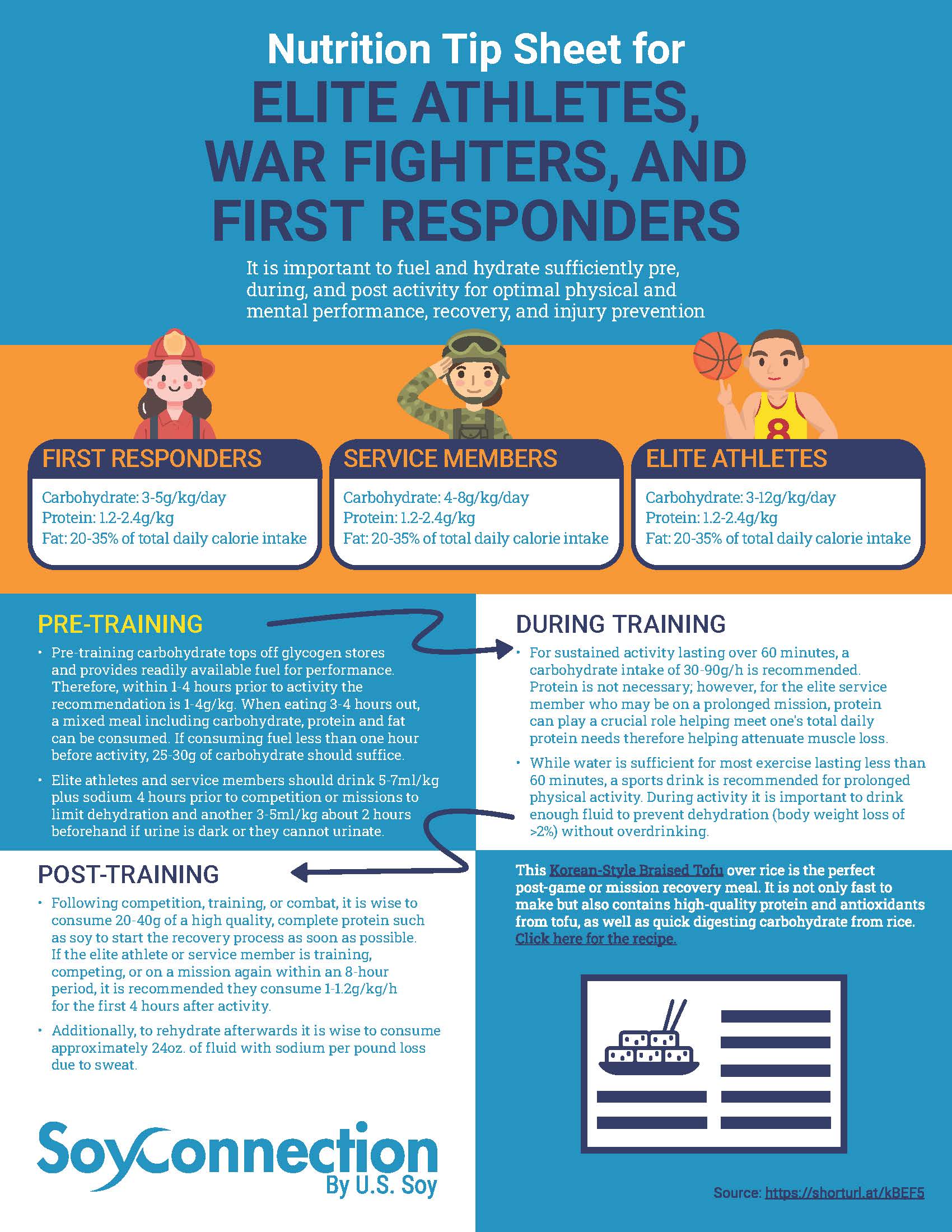Optimal nutrition plays a pivotal role supporting the extreme physical and cognitive demands placed on elite athletes, military service members, and first responders. These populations operate in challenging environments that require individualized evidence-based dietary strategies to enhance performance, health, and recovery.
Unique Nutrition Demands
Elite athletes follow training macrocycles to ensure they peak at specific times of the year. These periods typically include pre-season, competition season, and off-season. Nutrition requirements depend on the macrocycle, workload (mode, frequency, intensity, and duration), environment and individual factors including body composition, and metabolic rate.1
Unlike elite athletes, service members and first responders must be ready to perform their best year-round. It is challenging to accurately predict energy, carbohydrate, and hydration demands in these individuals due to the unpredictable nature of sustained operations or crisis responses. The duration, type of activity, environment, and load or carrying requirements (typically 10-50kg) can vary substantially between operations. These individuals may be exposed to extreme heat, cold, and high altitude sometimes with little to no time to acclimate. The unpredictable nature of the job for the service member and first responder can lead to short term or prolonged energy imbalance affecting their physical and mental performance as well as risk for injuries.2
Performance, Recovery, and the Role of Soy
It is crucial that elite athletes, service members, and first responders regularly consume sufficient calories to meet their training demands, recovery needs, and avoid the consequences of low energy availability.
Energy needs for all of these groups can be approximated using a resting metabolic rate (RMR) equation. As an example, female soccer players may require approximately 3,000 calories/day while an ultra-endurance athlete may require up to 7,000 calories/day.3,4 Many athletes, particularly female athletes, operate in a calorie deficit which may not only compromise performance but also health.5
Calorie needs of service members vary tremendously with reported ranges from 2,342 calories in female combat support personnel to 7,122 calories in male marines.6,7 Despite their high calorie needs, some service members operate under a large deficit totaling 40-70% of total energy needs (2,500 to 4,500 calories/day) during sustained training or combat situations. This can lead to declines in strength and power, decreases in mental and physical performance, and self-reported increases in depression, anger, fatigue, and confusion.8,9 Service members can use high-calorie rations during periods of increased caloric demands although rations might not completely bridge the gap in calorie needs.10
Carbohydrates are the main source of fuel sustaining both anaerobic and aerobic endurance performance. The elite athlete requires 3-12g/kg carbohydrate/day with endurance athletes on the higher end of this range.11 Approximate carbohydrate needs for service members are 4-8g/kg/day.2 Specific carbohydrate needs for first responders start at 3-5g/kg/day.2
Fat intake can also be manipulated to support one's energy needs. In general, all of these individuals can follow the Acceptable Macronutrient Distribution Range of 20-35% of total calories from fat.
Protein needs for elite athletes range from 1.2-2.0g/kg/day to support metabolic adaptation, immune function, repair of muscle and connective tissue, and accretion of lean mass.11 However, some athletes, including endurance athletes and bodybuilders, as well as those in a caloric deficit, may benefit from increasing their intake to up to 2.4g/kg/day to decrease muscle mass losses.11
Most first responders can follow the recommended protein ranges for athletes. Service members may want to consider the higher end of this range due to the extreme physical stress of their job. Service members often find themselves in negative protein balance during missions which may impair physical performance and increase risk of injury and lost duty time thereby diminishing warfare readiness.2
In addition to paying attention to total protein intake, protein quality should be considered. Soy foods are nutrient-rich and a good source of high-quality protein that support the retention and accrual of muscle mass. In fact, soy foods stand out among plant foods as soy protein is similar in quality to animal protein.11
Responding to Common Questions About Soy
Long term soy protein intake can support athletic performance especially in sports associated with muscle damage or strenuous exercise. Soy protein can also boost antioxidant defense and limit peroxidation which can lead to tissue damage.12
While some individuals have asked if soy protein is as beneficial as whey protein, a meta-analysis of long-term intervention studies (>6 weeks) comparing supplementation with soy protein versus animal protein answered this question. This meta-analysis found both animal protein, including whey, and soy lead to significant increases in strength and lean body mass with no differences between the two.13
Prolonged physical exertion, exposure to environmental stressors, and psychological strain can contribute to fatigue, muscle damage, and impaired cognitive function in elite athletes, service members, and first responders. Evidence-based nutrition strategies and an individualized approach can be used to adequately fuel these individuals, thereby optimizing performance, recovery, and resilience while mitigating the risk of injury, illness, and burnout.

References
- Thomas DT, Erdman KA, Burke LM. American College of Sports Medicine Joint Position Statement. Nutrition and Athletic Performance. Med Sci Sports Exerc. 2016 Mar;48(3):543-68.
- Gonzalez DE, McAllister MJ, Waldman HS et al. International society of sports nutrition position stand: tactical athlete nutrition. J Int Soc Sports Nutr 2022;19(1):267-315.
- Nikolaidis PT et al. Nutrition in Ultra-Endurance: State of the Art. Nutrients 2018;10(12): 1995.
- Dasa ME et al. Energy expenditure, dietary intake and energy availability in female professional football players. BMJ Open Sport Exerc Med 2023; 9(1): e001553.
- Jenner SL et al. Dietary Intakes of Professional and Semi-Professional Team Sport Athletes Do Not Meet Sport Nutrition Recommendations—A Systematic Literature Review. Nutrients 2019; 11(5): 1160.
- Baker-Fulco CJ, Kramer FM, Lesher LL, et al. Dietary intakes of female and male combat support hospital personnel subsisting on meal-focused or standard versions of the meal, ready-to-eat. Army Res Inst Env Med. 2002; https://apps.dtic.mil/sti/citations/tr/ADA406726
- Hoyt R, Jones T, Stein T, et al. Doubly labeled water measurement of human energy expenditure during strenuous exercise. J Appl Physiol 1991;71(1):16–22.
- Nindl BC, Leone CD, Tharion WJ, et al. Physical performance responses during 72 h of military operational stress. Med Sci Sports Exerc 2002;34(11):1814–1822.
- Castellani J, Nindl B, Lieberman H, et al. Decrements in human performance during 72-84 hours of sustained operations. J Spec Oper Med 2006;11(1):9.
- Nindl, B. C., et al. Nutrition Needs of Warfighters During Operational Deployments: Accurate and Actionable Metrics Are Needed for Food and Nutrition Research. The Journal of Nutrition 2017;147(11), 2013S-2020S.
- Spano M, Kruskall L, Thomas T. Nutrition for Sport, Exercise, and Health. Human Kinetics Publishers 2023.
- Zare R et al. Effect of Soy Protein Supplementation on Muscle Adaptations, Metabolic and Antioxidant Status, Hormonal Response, and Exercise Performance of Active Individuals and Athletes: A Systematic Review of Randomised Controlled Trials. Sports Med 2023;53(12):2417-2446.
- Messina M, Lynch H, Dickinson JM, Reed KE. No Difference Between the Effects of Supplementing With Soy Protein Versus Animal Protein on Gains in Muscle Mass and Strength in Response to Resistance Exercise. Int J Sport Nutr Exerc Metab 2018;28(6):674-685.

Connect with us through our social channels